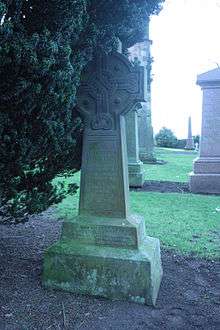John Hill Burton
| John Hill Burton | |
|---|---|
|
A bust of John Hill Burton as portrayed on his wife's grave in Dean Cemetery in Edinburgh (carved by William Brodie in 1881) | |
| Born |
22 August 1809 Aberdeen, Scotland |
| Died |
10 August 1881 (aged 71) Edinburgh, Scotland |
| Nationality | Scottish |
| Occupation | advocate, historian, economist |


John Hill Burton FRSE (22 August 1809 – 10 August 1881) was a Scottish advocate, historian and economist. The author of "Life and Correspondence of David Hume", he was secretary of the Scottish Prison Board (1854–77), and Historiographer Royal (1867-1881).
Life
Burton was born in Aberdeen, the son of W K Burton by his spouse Eliza Paton. He was educated at Aberdeen Grammar School and Marischal College. After graduating, he moved to Edinburgh and studied for the Bar, being admitted to the Faculty of Advocates in 1831. In 1832/3 the address of "J.H. Burton advocate" was given as 12 Fettes Row, a fashionable address in the Second New Town.[1] However, he had little practice, and in 1854 was appointed Secretary to the Prison Board of Scotland, and in 1877 a Commissioner of Prisons.
He became at an early period of his life a contributor to Blackwood's Magazine and other periodicals, and in 1846 published a life of David Hume, which attracted considerable attention, and was followed by Lives of Lord Lovat and Lord President Forbes. He began his career as a historian by the publication in 1853 of History of Scotland from the Revolution to the Extinction of the last Jacobite Insurrection, to which he added (1867–70) History of Scotland from Agricola's Invasion to the Revolution, in 7 vols., thus completing a continuous narrative. Subsequently he published a History of the Reign of Queen Anne (1880). Other works of a lighter kind were The Book-Hunter (1862), and The Scot Abroad (1864). Burton's historical works display much research and a spirit of candour and honesty, and have picturesque and spirited passages, but the style is unequal, and frequently lacks dignity. Nevertheless, he was one of the first historians to introduce the principles of historical research into the study and writing of the history of Scotland.
Burton died at his then home, Morton House on the southern edge of Edinburgh.
He is buried in Dalmeny churchyard with his infant daughter Rose (1857-1858), to the north-east of the church, the stone cross being partly obscured by a large yew tree on its south side which screens it from the centre of the churchyard. The monument to his first wife, Isabella and their joint children is in Dean Cemetery and this bears a fine portrait head of Burton in high relief sculpted by William Brodie.
Family
John Hill Burton married Isabella, née Lauder (born 1810) in 1844. She died in 1850.
He remarried in 1855 to Katherine, daughter of Cosmo Innes, and an outhor in her own right, who gave birth the next year to W. K. Burton. They had nine children in total.[2] Another of their children, Mary Rose Hill Burton, was a notable artist. A further son, Cosmo Innes Burton (1862-1890) was a short-lived but noteworthy chemist and a Fellow of the Royal Society of Edinburgh.[3]
References
- The Dean Cemetery, Edinburgh edited by A S Cowper, and Euan S McIver, Edinburgh, 1992, ISBN 0-901061-54-9
- Cousin, John William (1910). "
 Burton, John Hill". A Short Biographical Dictionary of English Literature. London: J. M. Dent & Sons. Wikisource
Burton, John Hill". A Short Biographical Dictionary of English Literature. London: J. M. Dent & Sons. Wikisource -
 This article incorporates text from a publication now in the public domain: Cousin, John William (1910). A Short Biographical Dictionary of English Literature. London: J. M. Dent & Sons. Wikisource
This article incorporates text from a publication now in the public domain: Cousin, John William (1910). A Short Biographical Dictionary of English Literature. London: J. M. Dent & Sons. Wikisource - Masson, David (1892). "John Hill Burton". Edinburgh Sketches and Memories. London: Adam and Charles Black. pp. 372–383.
- Burton, The Book-Hunter. A New Edition, with a Memoir of the Author (1860/2; 1882 edition)
-
 Chisholm, Hugh, ed. (1911). "Burton, John Hill". Encyclopædia Britannica (11th ed.). Cambridge University Press.
Chisholm, Hugh, ed. (1911). "Burton, John Hill". Encyclopædia Britannica (11th ed.). Cambridge University Press.
External links
- Works by John Hill Burton at Project Gutenberg
- Works by or about John Hill Burton at Internet Archive
- Lives of Simon Lord Lovat, and Duncan Forbes, of Culloden John Hill Burton, 1847, (Chapman & Hall, London)
- Narratives from criminal trials in Scotland, Vol. 2 John Hill Burton, 1852, (Chapman & Hall, London)